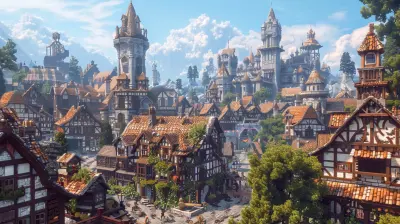17 April 2025
Ever wondered what goes into making those jaw-dropping, iconic console games that leave you glued to your couch late at night? It's not as simple as coding a couple of lines and watching magic happen. Nope, creating a legendary game is more like orchestrating a symphony—a perfect mix of creativity, technical wizardry, and sheer determination. From brainstorming wild ideas to polishing every digital pixel, the process is nothing short of fascinating. So, grab your favorite snack, sit back, and let’s take a deep dive into what really happens behind the scenes.![]()
The Spark: From Concept to Core Idea
Let’s start at the beginning. Every great console game begins with a simple question: “What if…?” What if you were a plumber saving a princess in a mushroom kingdom (we see you, Super Mario)? What if you could explore a dystopian world overrun by clickers (The Last of Us, anyone?)? Or what if you could race your friends across fantastical tracks filled with banana traps (Mario Kart, classic)?The conceptual phase is all about imagination. It’s where game designers and creative leads gather in a room (or these days, on a Zoom call) to throw ideas around. Think of it like a brainstorming session on steroids. They outline the core mechanics—everything from the story, gameplay, and characters to the kind of feelings they want players to experience. Want suspense? Let’s add a gripping plot twist. Craving immersion? Why not build an open-world setting?
Here’s where the magic starts to take shape, but hold your horses—it’s just the tip of the iceberg.![]()
Building Blocks: Storyboarding and Prototyping
Once the game concept is clear, it’s time to storyboard the entire thing. This stage is akin to sketching blueprints for a dream home you’re about to build. Developers map out the key stages of the game, the characters’ journey, and yes, even those infuriating boss battles that make you hurl your controller across the room.But here’s the kicker—ideas are just ideas until prototyping begins. Game developers create what’s called a "vertical slice" of the game. It’s like a tiny demo that showcases the game’s core mechanics and features. It’s rough, it’s clunky, but it’s proof of concept.
At this point, you might think it’s all fun and games (pun intended), but this phase often reveals big challenges. The prototype might play completely differently than expected, forcing the team to pivot. Think of it like trying a new recipe—sometimes you nail it, other times it’s back to the drawing board. ![]()
The Heartbeat: Development and Coding
Here’s where the rubber meets the road. Once the prototype gets the green light, developers get down to serious business—writing code. Lots and lots of code. And we’re not talking about your college-level “Hello, World” program. Developing a console game involves millions of lines of code to make sure everything works seamlessly—from the timing of actions to how characters interact with the environment.This stage is like constructing a skyscraper. Engineers (read: programmers) work on the game engine, the backbone that powers everything. Whether it’s Unity, Unreal Engine, or a custom-built one, the game engine drives physics, graphics, sound, and more. Meanwhile, other team members focus on making the game world come alive. They refine mechanics, build AI behaviors, and, of course, sprinkle in Easter eggs for players to discover later. (Because who doesn’t love finding hidden goodies?)
Graphics: Beauty Is in the Details
Once the nuts and bolts of the gameplay are secured, the artists take the stage. If coding lays the foundation, game design brings the house to life with stunning visuals. And oh boy, the level of detail these artists put into their craft is absolutely mind-blowing.Character designers flesh out 3D models of heroes, villains, and NPCs (non-playable characters). Environmental artists craft intricate landscapes—whether it’s sprawling mountains, neon-lit cities, or post-apocalyptic wastelands. Fans of Ghost of Tsushima know what I’m talking about; the visuals in that game could belong in an art gallery.
And let’s not forget about lighting and textures. Lighting artists set the tone for every scene, whether it's a creepy dark hallway or a sunny meadow. Meanwhile, texture artists ensure every blade of grass or piece of armor looks as lifelike as possible. ![]()
Immersion Matters: Sound Design and Music
What’s an epic battle without a booming soundtrack? Or a horror game without eerie silence followed by sudden spine-chilling shrieks? Sound design and music are the unsung heroes of game development.From the clink of swords to the whisper of leaves in the wind, every sound is carefully crafted to pull you further into the game’s world. Developers hire Foley artists (yes, like in movies) to record real-life sound effects. For instance, breaking a celery stick might become the sound of a crunching zombie bone. Creepy, right?
And then there’s the music. Composers work hand-in-hand with developers to create a score that matches the game’s vibe. Think of the adrenaline-pumping beats of DOOM or the emotional piano pieces in Final Fantasy. Music doesn’t just enhance the experience—it defines it.
Testing, Testing, and More Testing
Here’s a secret: Every game you’ve ever played—yes, even your favorites—was riddled with bugs at some point. And no, we’re not talking about creepy crawlies; we mean glitches, crashes, and weird quirks that break the game.To squash these bugs, games go through rigorous testing. QA (Quality Assurance) testers play the game over and over and over again. (Sounds fun, right? It’s not!) Their job is to break the game so developers can fix it. Imagine running into a wall 500 times just to see if the game crashes. It’s tedious, but it’s absolutely vital to delivering a polished experience.
The Final Sprint: Marketing and Pre-Launch Crunch
As launch day approaches, the pressure amps up to 11. Developers enter what’s notoriously known as the “crunch” phase. During this period, late nights and long hours become the norm as the team works tirelessly to meet deadlines. It’s like cramming for a final exam, except this exam could make or break years of work.At the same time, the marketing team is busy hyping up the game. Trailers, gameplay demos, and teasers flood the internet, building anticipation among fans. Remember the trailer for Cyberpunk 2077? It had people losing their minds with excitement (even though the launch, well… you know how that went).
Post-Launch: The Journey Isn’t Over
You’d think the work is done when the game finally hits the shelves, right? Not quite. The post-launch phase is almost as crucial as development itself. Developers monitor feedback, release patches to fix any missed bugs, and sometimes roll out DLCs (downloadable content) to keep players engaged.Games like Minecraft and Fortnite thrive on post-launch updates, evolving with new content and features. In today’s gaming world, launch day is just the beginning of a much larger journey.




Monica King
This article is a delightful peek behind the curtain! It's fascinating to see how these pixelated wonders come to life. Who knew some of our favorite console games had such quirky, hilarious origins? Can't wait to dive into more game-making magic! 🎮✨
April 18, 2025 at 3:44 PM